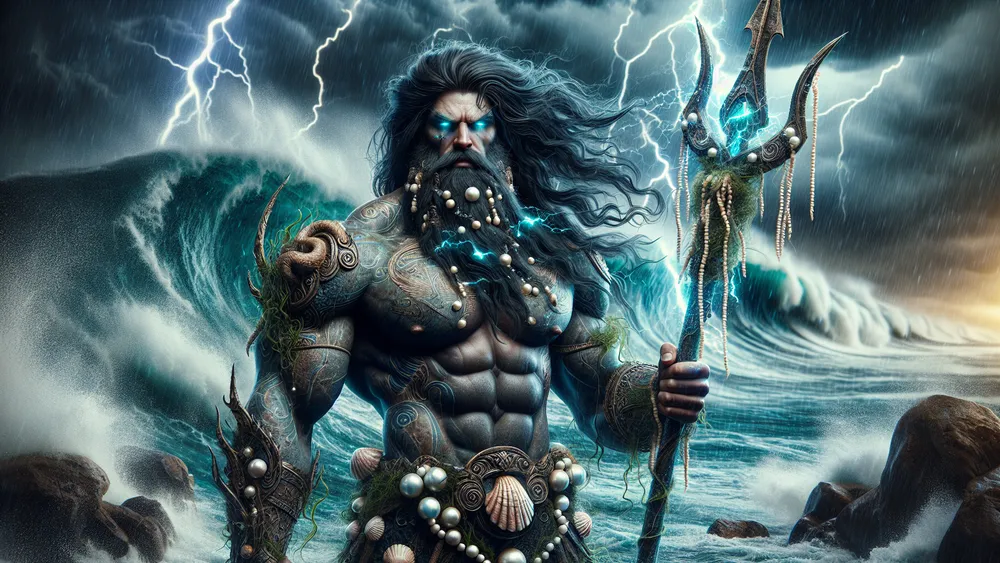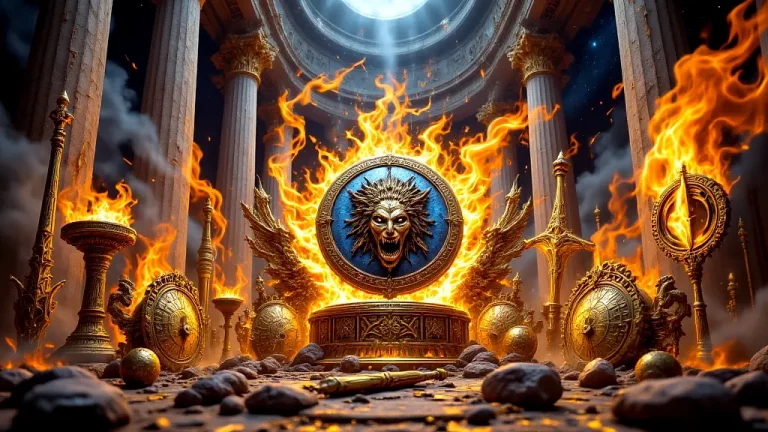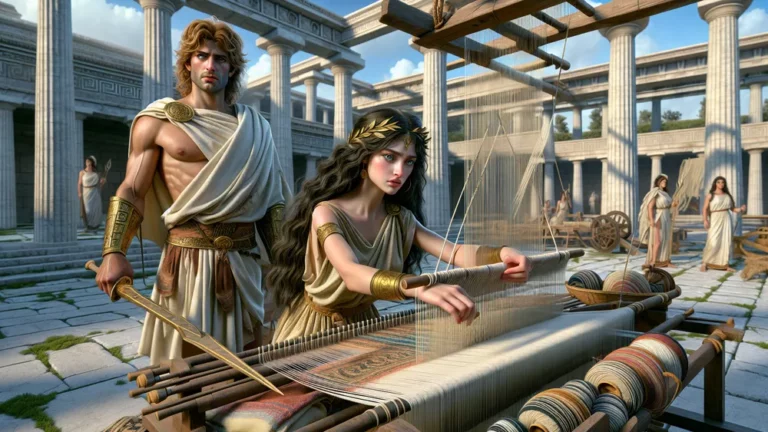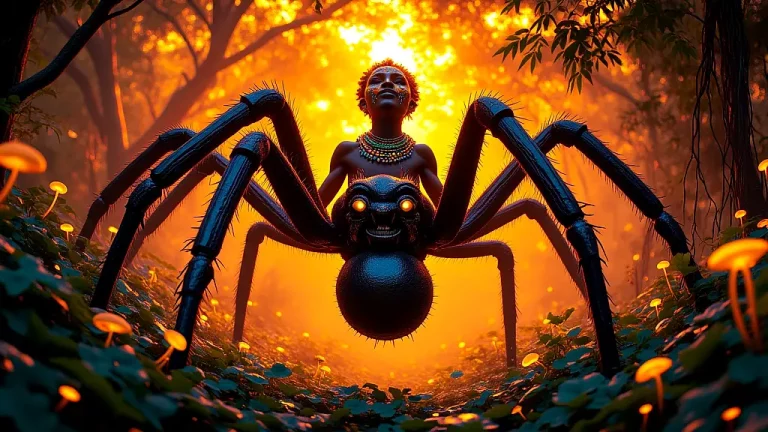Poseidon: Greek God Of The Sea, Storms, And Earthquakes
Welcome to a look at Poseidon, one of the most very interesting figures in Greek gods’ stories. As the god of the sea, storms, and earthquakes, Poseidon’s effect was big and reached many parts of Greek life. Imagine a world where the sea, being both crucial for life and a powerful force – Poseidon was thought to handle this strong domain.
Key Points:
- Poseidon is the Greek god of the sea, storms, and earthquakes, with his symbols being the trident, dolphin, and horse.
- Born from the ancient gods Cronus and Rhea, Poseidon was saved from being swallowed by his father and grew up with his siblings Zeus, Hades, Hera, Demeter, and Hestia.
- After a huge fight, called the Titanomachy, Poseidon and his brothers Zeus and Hades took control of the world, with Poseidon ruling the sea.
- Poseidon had many lovers, including Amphitrite, Medusa, and Thoosa, resulting in a number of children who played key roles in various myths.
- Famous stories about Poseidon include his fight with Athena for the city of Athens, his role in the Trojan War, and his anger towards Odysseus in the Odyssey.
- Ancient Greeks honored Poseidon through temples, festivals and rituals, seeing him as a guardian of sailors and controller of marine life.
- Poseidon’s relationships with other gods were complex, marked by occasional conflict and rivalry, notably with his brother Zeus and Athena.
In this blog post, we will dig into the many sides of Poseidon’s character and his importance in the Greek gods’ group. From the time he was born and his family roots to his many lovers and kids, we will uncover the myths around him. We will also see his areas and symbols like his known trident and holy animals including the dolphin and horse.
Notably, we will tell some of the famous stories about Poseidon, like his part in the Trojan War and his great anger toward Odysseus. Lastly, we will see how Poseidon was honored in old Greece, how he dealt with other gods, and his lasting meaning to Greek culture. So, whether you are new to mythology or already love it, join us as we go through Poseidon’s myth world.
Poseidon: Overview and Key Facts
| Main Point | Information |
|---|---|
| Name | Poseidon |
| Area | God of the Sea, Storms, and Earthquakes |
| Emblems | Trident, Dolphin, Horse |
| Parents | Cronus and Rhea |
| Brothers and Sisters | Zeus, Hades, Hera, Demeter, Hestia |
| Partners | Amphitrite, Medusa, Thoosa, among others |
| Famous Children | Theseus, Triton, Polyphemus, Pegasus, Orion, among others |
| Holy Animals | Horse, Dolphin, Bull |
| Big Stories | Fight with Athena for Athens, Part in the Trojan War, Anger at Odysseus |
| Worship | Temples, Festivals (like Isthmian Games), Rituals |
| Importance | Guardian of sailors, marine life controller, brings storms and earthquakes |
| Roman Name | Neptune |
Poseidon’s Roots and Family
To really get Poseidon’s spot in Greek stories, we should first look at his beginnings and family links within the group of gods.
Poseidon’s Birth and Family Tree
Poseidon’s parents were Cronus and Rhea, who were ancient gods in Greek stories. Cronus was afraid of a prophecy. So he swallowed his children when they were born. But Rhea saved Poseidon by hiding him and tricking Cronus with a stone wrapped in swaddles. Growing up, Poseidon was with his siblings – Zeus, Hades, Hera, Demeter, and Hestia – who all had important parts in the Greek gods’ group.
Ancient Greek gods can be seen as a big family with many complicated relationships. Poseidon’s spot among the Olympian gods appeared sure after the Titanomachy, the big fight between the Titans and the Olympians. He and his brothers Zeus and Hades won. This led to the division of the world among the three brothers, and Poseidon gained control over the sea.
Poseidon, part of a family of ancient Greek gods, secured his place ruling the sea alongside his brothers Zeus and Hades after they defeated the Titans in a great battle, dividing the world between them.
Poseidon’s Lovers and Kids
Poseidon had many different affairs, which means he was powerful and unpredictable. Among his most important partners is Amphitrite, a sea goddess who became his queen. Triton, a merman who served Poseidon, came from their union. Another important partner is Medusa, who had the winged horse Pegasus and the giant Chrysaor after her sad change into a Gorgon. With the nymph Thoosa, Poseidon also had Polyphemus, the famous Cyclops.
These relationships and kids mean a lot to many myths, showing Poseidon’s big influence across different stories.
Poseidon’s kids often had big parts in various myths, each adding to many parts of Greek stories. For example, Theseus, one of Poseidon’s sons with Aethra, is famous as a hero who defeated the Minotaur. He united the region of Attica. Orion, a giant huntsman born because of Poseidon’s union with Euryale, is another important figure who was placed among the stars as a constellation. Here’s a list of some of Poseidon’s important partners and kids:

- Amphitrite: Mother of Triton
- Medusa: Mother of Pegasus and Chrysaor
- Thoosa: Mother of Polyphemus
- Aethra: Mother of Theseus
- Euryale: Mother of Orion
These relationships and their kids highlight Poseidon’s complex and many-sided character, and his big impact on different mythological stories.
Poseidon’s Realms and Symbols
Since we’ve looked at Poseidon’s beginnings and family, it’s time to see the realms he controls and the symbols that mean his power.
Ruler of the Sea
Poseidon’s control over the sea stands out as one of his main traits. He appears as the main ruler of all sea creatures and huge oceans. Picture Poseidon guiding the waters and commanding the creatures within. His power covered every part of the sea. From small fish to big sea monsters. Sailors and seafarers appeared to respect Poseidon, often praying to him for safe trips and calm waters.
His influence was so strong that he was believed to create new islands and calm or stir the seas whenever he wanted. This control over the sea world made Poseidon a vital god for those who depended on the ocean, which shows his big role in Greek stories.

Master of Storms and Earthquakes
Poseidon’s control over storms and earthquakes went past the sea, giving him the name “Earth-Shaker.” Picture Poseidon using his trident to call storms and make the ground shake. In Greek mythology, people believed that Poseidon could make the oceans turn into violent storms. He was a god sailors both respected and feared.
His ability to cause earthquakes was linked to his anger. He would strike the earth with his trident and make it shake. These natural events were seen as signs of his immense power and changeable nature, showing his important role in how the Greeks understood the world’s wild and often harmful forces.
Poseidon’s Symbols and Sacred Creatures
Poseidon’s symbols and sacred creatures are full of meaning. Each one means a different part of his godly power. The trident, his most famous symbol, means a king’s scepter. It shows his control over the sea and his ability to manage its waters. The dolphin, often seen with Poseidon, means his kind side. It shows his connection to marine life. The horse is another special creature. It highlights his role as the creator of horses and his control over both land and sea. Here’s a list of Poseidon’s main symbols and sacred creatures:
- Trident: Shows control over the sea.
- Dolphin: Means his connection to marine life and his kindness.
- Horse: Shows his role as the creator of horses and his control over both land and sea.
These symbols and creatures not only tell us about Poseidon’s character but also mean his wide and varied influence in Greek stories.
Poseidon’s symbols reveal his power and character through objects like the trident, dolphin, and horse, each representing different aspects of his influence and abilities.
Poseidon’s Stories and Legends
After we looked at Poseidon’s areas and symbols, we will now examine the interesting tales and stories. They feature this powerful god.
The Battle for Athens
The story of Poseidon’s competition with Athena for control over Athens is an interesting tale of a godly competition. Imagine a big competition where two powerful gods present their best gifts to the city. The sea god Poseidon hit the ground with his trident and made a salty spring.
This gift meant his power over the seas and promised strong ships to the people of Athens. But the water from the spring was salty, so it wasn’t good for drinking or farming. It was not useful right away. Athena, the goddess of wisdom and war, gave another gift. She planted an olive tree that gave the people wood, oil, and food.
The olive tree meant peace and good fortune, giving real help that would last for many years. The people of Athens saw the long-term value in Athena’s gift and picked her as their main god. So, the city was named Athens for her.
This story shows the different ways the two gods thought and tells us the importance of wisdom and usefulness in building a civilization.
Poseidon and the Trojan War
Poseidon’s role in the Trojan War is proof of his complicated personality and the complicated ties among the gods. Imagine a powerful figure backing one side. It greatly changes the course of a big conflict. Poseidon supported the Greeks during the Trojan War because he held a grudge against the Trojans for not keeping a promise.
In the myth, Poseidon and Apollo built the walls of Troy for King Laomedon, who then refused to pay them. This made Poseidon want to see Troy fall. During the war, Poseidon helped the Greeks with his powers and often stepped into battles to help them win. Poseidon’s support for the Greeks, though, had complications.
His actions caused conflicts with other gods who liked the Trojans, like Apollo and Aphrodite. For instance, Poseidon and Apollo fought on the battlefield, each helping their side. Despite these godly fights, Poseidon was key in important events, such as the building of the Greek fortifications and breaking down the walls of Troy.
His role shows that, in ancient Greek myths, gods were believed to take active and often contentious roles in human affairs, affecting the outcomes of human conflicts.
Poseidon’s Anger: The Tale of Odysseus
Poseidon’s anger towards Odysseus is one of the most interesting parts of Homer’s Odyssey. Imagine a powerful figure being so angry. They use all their influence to create obstacles. This is exactly what Poseidon did to Odysseus. It all started when Odysseus blinded Polyphemus, the Cyclops and Poseidon’s son.
After getting away from Polyphemus’s cave, Odysseus made a big mistake by saying who he was, which made Polyphemus ask his father for revenge. Poseidon, very angry because of what happened to his son, promised to make Odysseus’s trip back to Ithaca very hard. Throughout the Odyssey, Poseidon’s anger appears in many challenges and delays.
For example, Poseidon sends a huge storm to wreck Odysseus’s ship, which makes him go to the island of the Phaeacians. Another key moment is when Poseidon turns the Phaeacian ship to stone for helping Odysseus. These actions show Poseidon’s power and his non-stop chase for revenge. Even with many obstacles from Poseidon, Odysseus’s cleverness and strength help him beat the god’s anger and get home.

This long fight between a mortal hero and a powerful god underscores the themes of perseverance and the unpredictable nature of the gods in Greek myths.
Worship and Cult of Poseidon
After looking into Poseidon’s myths and stories, now let’s focus on how this powerful god was worshiped in ancient Greek culture.
Poseidon’s Temples and Holy Places
Think about visiting very old places with huge cultural and religious importance. Poseidon’s temples and sacred places were spread out across Greece, each having its own story and features. Below is a list of big temples and sacred places for Poseidon:
| Temple/Site | Location | Historical Importance | Notable Features |
|---|---|---|---|
| Temple of Poseidon | Sounion | A big place overlooking the Aegean Sea | Perched on a cliff, stunning views |
| Isthmian Sanctuary | Corinth | Where the Isthmian Games, a big Panhellenic festival, were held | Ruins of the temple, old stadium |
| Poseidon’s Temple | Cape Tainaron | Thought to be an entrance to the underworld | Far-off place, old writings |
| Temple of Poseidon | Helike | A sunken city, which was once a big religious place | Underwater site for archaeology |
These places were not only for worship but also played big parts in the social and cultural life of ancient Greece.

Ancient temples dedicated to Poseidon in Greece were more than places of worship; they were central to the social and cultural life of the time, each with its own unique significance and remains, like the Temple of Poseidon in Sounion perched on a cliff with stunning views over the Aegean Sea.
Celebrations and Ceremonies
Think about being at a big celebration with sports events, religious actions, and group joy. The Isthmian Games, held for Poseidon, were such events like today’s Olympics. Every two years near the Isthmus of Corinth, there were sports events, chariot races, and musical contests.
People who took part and watched came from everywhere in Greece to honor Poseidon, seeking his favor and blessings. Besides the games, at Poseidon’s temples, they did rituals like sacrifices and offerings for safe sea trips and good harvests. These celebrations not only made Poseidon more important in Greek society, but they also helped create unity and a shared cultural identity among the Greek city-states.
Poseidon’s Interactions with Other Gods
After we looked into how Poseidon was worshiped, let’s dig into his complicated connections with other gods in the Greek pantheon.
Poseidon and Zeus
Think about the relationship between two strong siblings, each controlling their own area. Poseidon, the god of the sea, and Zeus, the king of the gods and ruler of the sky, had a relationship marked by both working together and having fights. They joined forces to overthrow their father, Cronus, and set up the Olympian order. But their fights often appeared in stories.
For example, in the Iliad, during the Trojan War, Poseidon went against Zeus’s order, highlighting their tense relationship. Another story tells of Poseidon’s attempt to overthrow Zeus with Hera and Athena’s help, which did not work and led to Poseidon’s temporary banishment. These stories focus on the complex mix of power and family ties between the two gods, showing bigger themes of control and rebellion in Greek myths.
Poseidon and Athena
Think about the stress between two strong figures, each trying to be on top in their own ways. Poseidon, god of the sea, and Athena, goddess of wisdom and war, had a relationship marked by both rivalry and sometimes working together. Their well-known fight happened during the contest for the patronage of Athens.
When Poseidon hit the ground with his trident, he created a saltwater spring, but Athena gave an olive tree to symbolize peace and prosperity. The citizens liked Athena’s gift better, so she became the city’s main deity. Even though they had this rivalry, there were times when they worked together, like when they built the ship Argo.

Athena provided guidance and Poseidon made sure the ship had a safe journey. These stories illustrate the complex and varied nature of their connections, mixing fights with moments of working together.
Pantheon of Greek Gods
Think about a big group of gods, each with their own powers and areas, working together to run the universe. The group of Greek gods is an interesting collection of gods and goddesses, each having a key role in stories and ancient Greek life.
From Zeus, who is powerful and rules the sky, to Hades, who takes care of the underworld, and Hera, the queen of the gods, these gods form a complex and connected family.
If you want to see the full list of these divine beings, you can find a detailed list of all the Greek Gods that talks about their traits and stories.
FAQs
1. What are Poseidon’s main symbols?
Poseidon’s main symbols include the trident, which represents his power over the sea, the dolphin, symbolizing his dominion over marine life, and the horse, reflecting his creation of the first horse and his connection to earthquakes.
2. How did Poseidon influence ancient Greek culture?
Poseidon influenced ancient Greek culture by shaping their seafaring practices, agricultural rituals, and city patronage through his divine authority over the sea, storms, and earthquakes.
3. What are some famous myths involving Poseidon?
Some famous myths involving Poseidon include his contest with Athena for the patronage of Athens and his role in the Odyssey.
4. How was Poseidon worshipped in ancient Greece?
Poseidon was worshipped in ancient Greece through various temples, festivals, and rituals dedicated to honoring his dominion over the sea, storms, and earthquakes.







